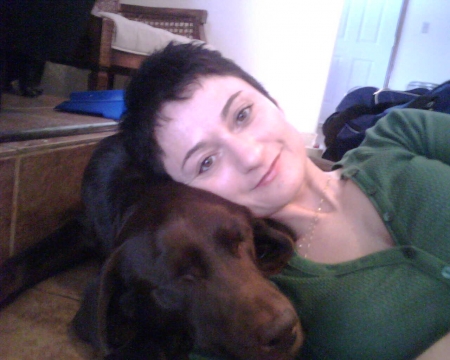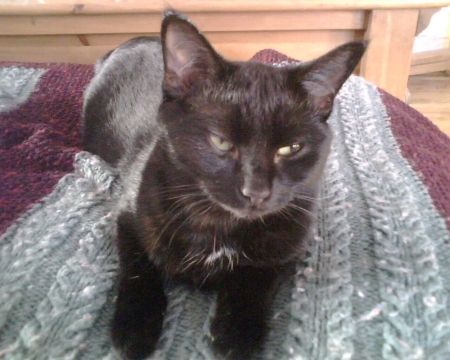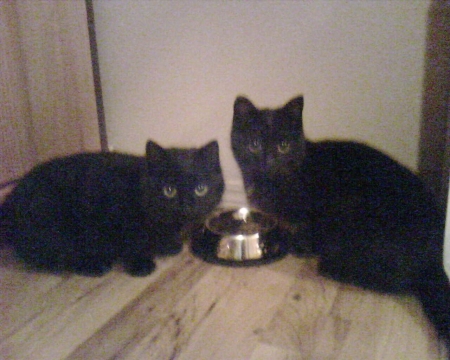

Strays struggle to survive winter’s bitter cold
When the weather warms up enough for spring blossoms to start showing their colorful faces, it’s not just human beings who have an extra spring in their step. Stray animals in cold weather climates can finally get some relief from the harsh conditions.
In wintertime, strays might freeze to death, or get frostbitten ears and paws. They have trouble finding water because it’s been frozen to ice. Food gets buried under the snow.
I grew up in one of Canada’s coldest inhabited regions. In the excruciating deep freeze of Winnipeg, Manitoba, temperatures can dip to minus 50 degrees Celsius with wind chill. Unexposed skin suffers frostbite in less than two minutes. Cars require block heaters that must be plugged in when vehicles aren’t running or the engine fluids will freeze.
It was the bitter sting of a Winnipeg winter that brought my first cat to me. It was 1975, and a blinding 23-hour blizzard had shut down the city. I was six, my brother was four. We wandered into the living room and stopped in surprise.
Sitting outside on the ledge of our front room picture window was a grey tabby cat. She stared in at us imploringly. Raging winds swirled sheets of white snow around her. She looked like a guppy as her mouth opened and closed in a pleading meow that was silenced by the glass that lay between us.
We quickly brought her into our warm house, where she promptly made herself at home. "Kitty", as we called her, would live to be 19 years old.
With a bit of effort and a touch of creativity, you can help strays in your community, too. This next story comes from Heather McKnight, another Winnipegger I’ve known since junior high school. Our mutual love of animals caused us to reconnect recently.
It turns out that besides being an animal rescuer, Heather is also good writer, so I asked her to tell her tale about how she saved two feral cats.
Editor’s note: When at all possible, I do not condone cats living outdoors. They are exposed to many dangers including licking antifreeze or other poisonous substances. They crawl into warm car engines where they get ripped apart by fan belts. They get locked in places such as sheds and garages. They might also be victimized by angry children or adults in the neighborhood — I’ve seen cats who have been shot by BB guns, wrapped in wire, or otherwise tormented. But in some instances, particularly in the case of feral cats, a life outdoors is unavoidable. The following story illustrates one of those times.
Raven and Finnegan found love, safety and food at Heather’s house.

Heather relaxes on her live dog pillow, five-year-old Scooby Doo.
Homeless cats luck out when a guardian angel crosses their path
By Heather McKnight
It was the beginning of April and winter was finally giving up its hold on Winnipeg. The sun was shining, the snow was melting, and the ditches were filling with water. Driving home one early evening, I decided to slow down past the house that some neighbors had moved into the previous summer. They had been renovating and I was curious to see how far along they were.
The whole family was out in the yard. The three boys and their friends were playing in a shallow, ice-filled ditch at the side of the house. Mom and Dad were stacking firewood just a few feet away. But that was not what caught my attention. Outside by the house front window were two tiny black cats.
In the country, this wouldn’t normally wave red flags. But my curiosity was raised because there were also two larger cats outside. The owners of the house in question, while nice, caring people, have no patience to take on more than what they feel is necessary.
I pulled into the driveway and got out of my car, making my way over to the small black cats. It turned out they were kittens. The woman told me that the mother cat had abandoned the kittens the previous fall. The kittens had stayed around the house.
When the cold weather came, this neighbor had made them a lean-to against the house to keep them out of the wind and snow. She had been feeding them during the winter but she said it now it was time for them to go. She didn’t want them to make a mess in her front gardens. This is what she considered beyond necessary.
I asked if she would be taking them to the animal shelter. Her answer was not what I had expected. Her husband was going to put them in a box and drop them off at a barn down the road.
I was horrified. I knew which barn they were referring to. While it was probably great for the cats who actually lived there by rights, it was not a place for young kittens without a mother. I knew that many of the kittens that had been born in that barn or dropped off there had been hit by cars on the nearby road. Or found frozen to death because they had wandered too far away from its shelter.
I was not going to let tragedy happen. I told her I would take both of them.
I took a quick drive home to get a carrier so I could pick up the kittens. They were so tiny. Both had a touch of frostbite on their ears, and they were skittish.
The neighbor said they were very friendly, and that her boys were able to pick up the female and carry her around. It soon became clear to me that if they had been hauling these cats around, it hadn’t been because the cats had a choice.
Once at home, I put them in the office. This space worked well because it is large, I could put their litter box in the bathroom, and it got wonderful afternoon sunlight. Also, it was their own space protected from the two dogs and three other cats that already lived in our house.
Until they were used to the family, I wanted them to have their own secure spot.
They quickly adjusted to being inside, but their skittish nature remained. The male, Finnegan, was the most responsive. He would let me get close to pet him, and occasionally he would allow me to give him a snuggle. The female, Raven, was harder to get near. You had to give her a food bribe just to get close. Both put on some much-needed weight in the first few weeks I had them.
Then things got a bit interesting.
I wasn’t sure of their ages. Before I could get them fixed, Raven went into heat. I have never experienced this with a cat before because I’ve always had them spayed or neutered before biology allowed this to happen.
Raven took one look at my neutered male cat Scrappy while she was in heat, and that was it. She was in love. She strutted around him. She was demure, she was coy. And she was very aggressive.
Poor Scrappy. He was out of his league. This behavior was completely foreign to him. He would smack her with his paw and wrestle her to the ground. Her response was to take it, and then wiggle her backside at him. He looked completely confused.
She was at the vet clinic within 24 hours. So was Finnegan.
Having decided five cats and two dogs were just too many animals in one house, my husband built a cat house outside for our new family members. Standing a few inches off the ground, it measures 4 feet by 2 ½ feet by 3 feet. It is completely insulated with a front door and two side windows for light. The door is large enough for the fattest cat, but small enough so the dogs can’t get in. It even has a little front porch.
There is enough room for a large bed area, and space for food and water. Intended for year-round use, it includes a socket for a heating lamp to be hooked up inside to keep the cats warm during the coldest winter nights and days.
The day finally came to move the black furballs to their new house outside. It was just a couple of yards from my back door, where it would be easy to keep an eye on them. The nights were no longer freezing, and the days were growing warmer.
Finnegan was first. Gathering him up in my arms, I took him outside for the first time in over a month. Taking him to the new house, I explained what was going on. That I would always feed and protect him. He could come inside anytime he wanted, but this would be his home base.
He didn’t buy it. He shot in, he shot out, and he disappeared under the deck of the house. Next it was Raven’s turn.
Same scenario. As soon as I popped her inside the new house she bolted out. I thought she went under the deck to be with her brother Finnegan.
My sons and I started circling the house. We looked under the deck, around the woodpile, the shed, the cars. Still no cats. The only remaining option was the woods. There is a small wooded lot to the south of our house, and one to the east. We searched and called to no avail.
As we stood outside wondering where on earth she went, my oldest son said to me, "Mom, maybe you should look at the living room window."
When I looked up at the large easterly window, there sat Raven. She had snuck inside and had been watching us while we had been looking for her. Sitting on the window ledge, she peered through the glass at us with a look on her face that said to me, "Really. You think I am going to settle for that? You think after sleeping on feathers and cushions in a heated home, I AM GOING TO SLEEP OUT THERE IN THAT?"
She has never forgiven me for having her spayed. She and Scrappy have bonded despite the aggressive early dating maneuvers. She spends most of her time in the house.
Finnegan has adapted better to a life outdoors — hunting mice and roaming with the other wild cats in the area. But he’s not a completely feral animal. We spot him on an occasion, silently slipping between the undergrowth of the forest, or sneaking into the herb garden for a hit of catnip.
Sometimes, early in the morning before the sun has started to rise, I spot him sitting on the back porch waiting for the dawn, enjoying the free meal I leave out for his comfort and sustenance. I think he’s pretending just for the moment that he’s domesticated.
But that’s our secret.

Join the newsletter and never miss out on dog content again!
"*" indicates required fields
By clicking the arrow, you agree to our web Terms of Use and Privacy & Cookie Policy. Easy unsubscribe links are provided in every email.
